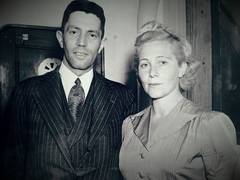Ramath Orah Stories
Ramath Orah Stories
Barbara Balk, Cincinnati, OH
Andrew Blumenthal, North Bethesda, MD
David Deutsch, New York, NY
Eda Eskin, Tel Aviv, Israel
Alice Henkin, New York, NY
Dr. Milton Koch, Bethesda, MD
Nicole Mayer, Katonah, NY
Claude Tzvi Marx, Vught, Netherlands
Wolfgang I. Rauner, Fresh Meadows, NY
Debbie Ross, Teaneck, NJ
Neil Rothfeld, New York, NY
Claude Salomon, Palmetto, FL
Meredith Wolf Schizer, New York, NY
Sarah Schleifer, Teaneck, NJ
Elana Steltzer, White Plains, NY
Dan Victor, New York, NY
Barbara Balk of Cincinnati, Ohio, recalls her early married days at Ramath Orah in 1980-82:
My husband [Rabbi Hanan Balk] was the shames [at Ramath Orah] when we lived at 510 West 110th St., in our first married apartment.
Having the key to the shul meant that we could use the sukkah, albeit after everyone else finished eating. I seem to remember that only one side of the table was actually considered the kosher side because the other side was under the overhang of the building.My husband went to daily minyan there but we went to Rabbi Kret’s shul, Old Broadway, on Shabbos. I once went to the megillah reading there. When I heard Haman’s name, I shook my grogger and everyone turned to look at me. I didn’t realize that it was such a “yekka” shul and no one made noise but me with my grogger! With the next sound of “Haman,” I was quiet like the rest of the congregation.
Simon Blumenthal was President of Ramath Orah. His grandson, Andrew of North Bethesda, Maryland, recalls growing up at the shul:
My dear grandparents (Opa and Oma), Simon and Hilda Blumenthal lived across the street and he was the President of the shul for many years. He built the beautiful center bimah as well as the special succah downstairs as well as made many other loving improvements to the beautiful synagogue.
My parents, Fred and Gerda Blumenthal with my sister, Roz and I lived one block away on 109th Street. We all loved and cherished growing up there, and even after we moved in 1977 to Riverdale, NY, my parents continued to be major contributors to the shul there, and to attend the annual shul dinners.
I remember singing Adon Olam and Yigdail at the Bimah almost every Shabbat that I could, going around the shul and getting hugged and kissed by all the elderly members at the time, and always looking up to the Ark of Torahs where my grandfather proudly sat next to them humbled and dedicated in his service to Ramath Orah shul and community.
While the shul was struggling at the time, we all always somehow believed that this beautiful synagogue would one day fully come alive again, which I understand it most certainly has.
President Simon
Blumenthal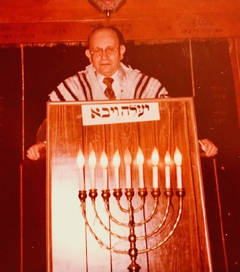
Simon and Hilda Blumenthal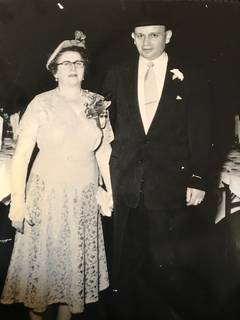
Fred and Gerda
Blumenthal 
Andy
Blumenthal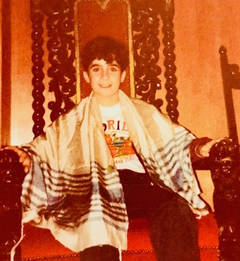
David Deutsch of New York, NY recalls visiting Ramath Orah in the 1990s:
I was studying Yiddish at YIVO between my second and third years at college, and went to various shuls in the neighborhood. One Shabbbos, I found myself at Ramath Orah. I had just begun to do teshuva, and had never done hagbah before, as I had a fear that I would pick up the sefer, and it would split down the middle. That Shabbos I was asked to do hagbah, and I thought "worst case scenario I never have to see these people again." So I did it, and I've since become a pillar of the hagbah community.
Eda Eskin of Tel Aviv recalls:
My parents Rajna and David Eskin were married at Ramath Orah on October 6, 1957 [pictured below]. Rabbi Robert Serebrenik officiated. After the wedding, my parents washed the dishes!
As a small child my mother used to bring my sister Tamar and me to the shul on Shabbat. My first impression on seeing Rabbi Serebrenik—at that time he dressed elegantly in a black cap and gown (white on Yom Kippur)—was that he was G-d. Every time he looked in our direction, I used to duck under the bench in the women's section...He looked supernatural.



Alice Henkin of New York, New York recalls:
We moved to Morningside Heights in 1962 before we had children, first to Claremont Avenue, and then to Riverside Drive. When we first came to Ramath Orah, the women spoke in Yiddish or German, and I remember Mrs. Serebrenik was very elegant. It was not at all crowded on Shabbat. There were no strollers or baby carriages, like there are today.
All three of our sons were bar-mitzvah’ed at Ramath Orah, and they were the only bar mitzvahs for many years. I remember at the end of each, their father told them to “go kiss your mother” up in the balcony. Our grandson had his bar mitzvah at Ramath Orah in 2014, and our granddaughter’s bat mitzvah is next week (June 2018).
We were at Ramath Orah through all of its Rabbis, and went out socially with Rabbi Morduchowitz, who Lou knew from Harvard, and his wife Elka. When we lived in Paris for a year when Lou was on sabbatical, I remember we even ran into Rabbi Ralbag there.
Lou was honored by Ramath Orah at its dinner in 2007, and Daniel and Alisa were honored in 2016. Ramath Orah is a family tradition.




Dr. Milton Koch of Bethesda, Maryland recalls:
Rabbi Serebrenik married my parents in Luxembourg, one month before Eichmann closed the border—1940. He also aided in getting my father, Max Koch, released from Dachau in 1939, which brought my father to Luxembourg. His late brother Oskar was married to my aunt—my father's sister—in Palestine/Israel.
After my parents left Luxembourg, they spent over one year in Lisbon, boarded a boat to Cuba, were there for four years, where I was born in Havana, and then came to New York City. They lived on 109th Street and were active at Ramath Orah. My uncle was Albert Nussbaum, executive secretary for the synagogue for many years.
Rabbi Serebrenik officiated at MY bar mitzvah, as well. It is possible that the picture of the rabbi with his hands raised for a bracha, may have been from my bar mitzvah pictures!! Below are some of my “staged” bar mitzvah pictures in the sanctuary in January 1958. The pictures include my father, the Rabbi, Cantor Nathan Kisner, and myself. The last picture is the social hall dinner the evening of my bar mitzvah (Jan. 4, 1958) with the rabbi and his wife and my family members—but not my uncle Albert Nussbaum, who was taking the pictures!
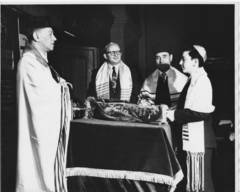
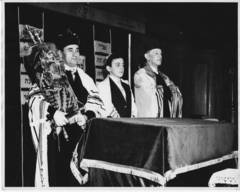
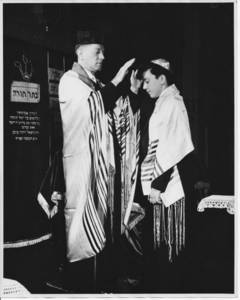
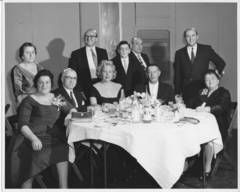
Claude Tzvi Marx of Vught, Netherlands recalls:
My father Andre Marx was the chazzan and Hebrew school [teacher] in Luxemburg before WWII. Rabbi Serebrenik gave him formal permission to serve as shochet also. We have the original handwritten "heter" document. I also have original photos of the Nazis burning the synagogue. These came via Fernand Klein זצ"ל. A copy is in Yad Vashem. My parents and my older brother Gerard escaped on May 10, the day the Nazis invaded Luxembourg, to France, where I was born in Montpellier on January 1942. After the war, my family came to NYC. Father served as chazzan sheni in the period somewhere around 1950-55 for High Holy Days. My brother Gerard and I sang in the choir that my father led. Memories include breaking fast at Milton Koch's family, especially the plum pie. Later memories include attending Luxembourg Society annual get togethers, eating the "stink" cheese, and Benny playing Luxembourg songs on the piano. Interestingly, all of my family with children and grandchildren became Luxembourg citizens in the last three years [written 2018].
Nicole Mayer, of Katonah, New York, and granddaughter of Ramath Orah's first President, Otto Wolf, recalls:
When I was a child, I remember Rabbi Serebrenik dressed all in black and scared me. He looked like Dracula. He was very good-looking and quite dramatic and his wife was a very pretty woman.
My grandfather, Otto Wolf, allowed me to sit on his lap on the bimah even though only men were generally allowed downstairs and the women's section was in the balcony.
We lived on West 73rd Street when we first moved to New York, and later moved to Washington Heights, where it was cheaper. My grandparents, Otto and Selma Wolf, purchased an area of the cemetery in New Jersey for Ramath Orah.
I also remember that the Luxembourg Jewish Society used to meet in the downstairs social hall to discuss ways to get restitution from the Luxembourg community, and at those meetings, we were able to get special cheese from Luxembourg that we couldn't get other times.
Wolfgang I. Rauner of Fresh Meadows, New York, writes:
I'm 89 years old and I may (possibly) be the only remaining member of the last transport with Rabbi Dr.Serebrenik z"l, arriving June 21, 1941, on the Mouzinho. I live in Queens, NY and because of distance & age have had no contact with the congregation for many years. I believe the last time I was in your shule was at my late sister's wedding (see pictures under Debbie Ross, below) performed by Rabbi Serebrenik in December 1950.
I do, however,have a permanent connection to the shule since my late father Aron Rauner was one of the original founding members and to the best of my knowledge there is a Sefer Torah in R.O. belonging to my family. It was lent to the congregation at its founding by my father (there's a long story attached).
I wish you great success in your upcoming dinner and "hatzlacha" over the next 75 years.Rabbi Dr. Robert Serebrenik & wife, nee Julia Herzog on arrival in New York on June 21, 1941 aboard the S.S. Mouzinho from Lisbon, Portugal

Rosters from ship showing Rabbi and Mrs. Serebrenik and Rauner family
Debbie Ross tells us about her (and sister Susan Sperber's) parents' wedding:
My parents, Walter and Gertrude (Rauner) Rosenthal, lived in Washington Heights before they were married at Ramath Orah on December 17, 1950 [the first we know of to have taken place at Ramath Orah]. Below is a picture of their invitation and a picture from their wedding. We held their 50th wedding anniversary at the synagogue as well, pictured below. My uncle is Wolfgang Rauner. Also pictured is some of the family in Luxembourg--my great grandmother (who didn't make it to the U.S.) my grandparents (the Rauners), my grandmother’s sister and brother in law (Hanau), and my mother and her three siblings and two cousins.
Wedding Picture Invitation


Neil Rothfeld of New York, New York recalls:
I first came to Ramath Orah in 1988 but did not return until ten years later, in 1998. Then, I was greeted by Dan Victor and I've never left. Rabbi Friedman was re-building the shul membership with his welcoming attitude. Friday night dinners were held in the freezing social hall but the feeling was very warm. Hard to believe, but kids were scarce at RO. In addition to my Rachel (7) and Avi (5), there were the children of the Victors, Goldmans, Telushkins, Newmans and Slepians. No one was under four!
Early on, I became interested in bikur cholim. A group was organized and volunteers included Rhoda Gruen, Suzanne Schwartz, Robin Michnick, Jane Blumenstein and myself. We went through a number of stages, visiting at St. Lukes and Amsterdam House. In time, we had a number of our own members who were homebound or needed assistance getting to shul. I became very involved with Rita Linhart, a member for half a century. She had lost two husbands and her friend, Mr. Korn, who used to come for lunch and make kiddush. Rita was always ready for her visitors with all sorts of treats. Mine were strawberries, Harry Slepian's were nuts. In addition to my family, Harry and Meira, Max and Stephanie, Judy Oshry, Mara Warren (Rotbard), Evelyn Cohen and Danny Reichwald listened to stories and celebrated birthdays. Rita had been on the last Kindertransport out of Germany to England. We were all inspired by her stories of survival, perseverance and faith.
The other aspect of the shul with which I'm most associated, is the Morning Minyan. I was inspired by Ari Goldman's "Living A Year Of Kaddish" about the difficulties in keeping a minyan going at RO but also the closeness among the attendees. I found myself in this position in 2004-05 (for my father) and in 2011-12 (for my mother). It was at the Morning Minyan that Rabbi Friedman encouraged me to lead services for the first time. After a difficult month (no minyan six times), I resolved that, one day, I would ensure that others saying kaddish would have a strong, reliable minyan and would neither have to be the one to gather a minyan or go elsewhere. Both former President Leo Chester and Professor Louis Henkin are credited with having declared that a shul without a Morning Minyan is not really a shul. That resonated with me. Stalwarts like Rabbi Grussgott, Dan Victor, Rabbi Schorsch, Jerry Kowalski, Len Brauner, Rabbi Gedzelman, Eric Fishman, Ross Boltyanskiy, Henry Watkin, Sam Daitch and Misha Zubarev have helped us attain a consecutive minyan streak of 485 and counting. Yaakov Kerzhner, Mark Kolber, Paul Appelbaum, and Scott Singer are committed to specific days of the week.
My wife, Carol Goldstein, brought many skills to RO, including leyning. This was put to use in the early 2000s when, after the men's hakafas, she asked Rabbi Friedman if she could lead a women's reading that Simchat Torah night. Rabbi Friedman said yes and this became the first women's reading on Simchat Torah.
On a recent Shabbat, I was very moved as Misha Zubarev spoke about his "15 Firsts" at RO, most of them at the Morning Minyan. If I've ever given thought to retiring as the minyan manager, Misha's speech made me realize how seemingly small things can impact on another person in a major way—from the person who helped him put on tefillin to asking him to give the dvar torah/halacha. I now look forward to greeting the next future member who walks in the door and assist him or her along their path of greater observance here at Ramath Orah.
Rachel and Avi with their grandparents,Anita and Murray Rothfeld, in the first Rachel and Avi visiting Rita
sukkah, in front of the shul, 2004 Linhart in 2005



Claude Salomon of Palmetto, Florida recalls her family's connection to Rabbi Serebrenik and the Luxembourg Jewish Society:
My parents, Estelle and Bernard (Benny) Salomon were among the Luxembourg Jews who settled in NYC in 1942. They were married by Rabbi Serebrenik in the Great Synagogue in Luxembourg in June 1939, and left Luxembourg in May 1940. After some time living in France with fake papers, they eventually were able to land in NYC where relatives already lived. They were active in the Luxembourg Jewish Society and were friends with many of the "founders."
Meredith Wolf Schizer of New York City recalls her daughters' bat mitzvahs in 2013 and 2016 at Ramath Orah:
Both of our daughters' bat mitzvahs were at Ramath Orah. Our eldest had a Sunday morning women's tefillah on Rosh Chodesh and our younger daughter leyned Megillat Ruth at a women's tefillah on a Sunday in May shortly before Shavuot. David and I have both said kaddish for our fathers at CRO. We've been members since we moved up to Morningside Heights in 2008.

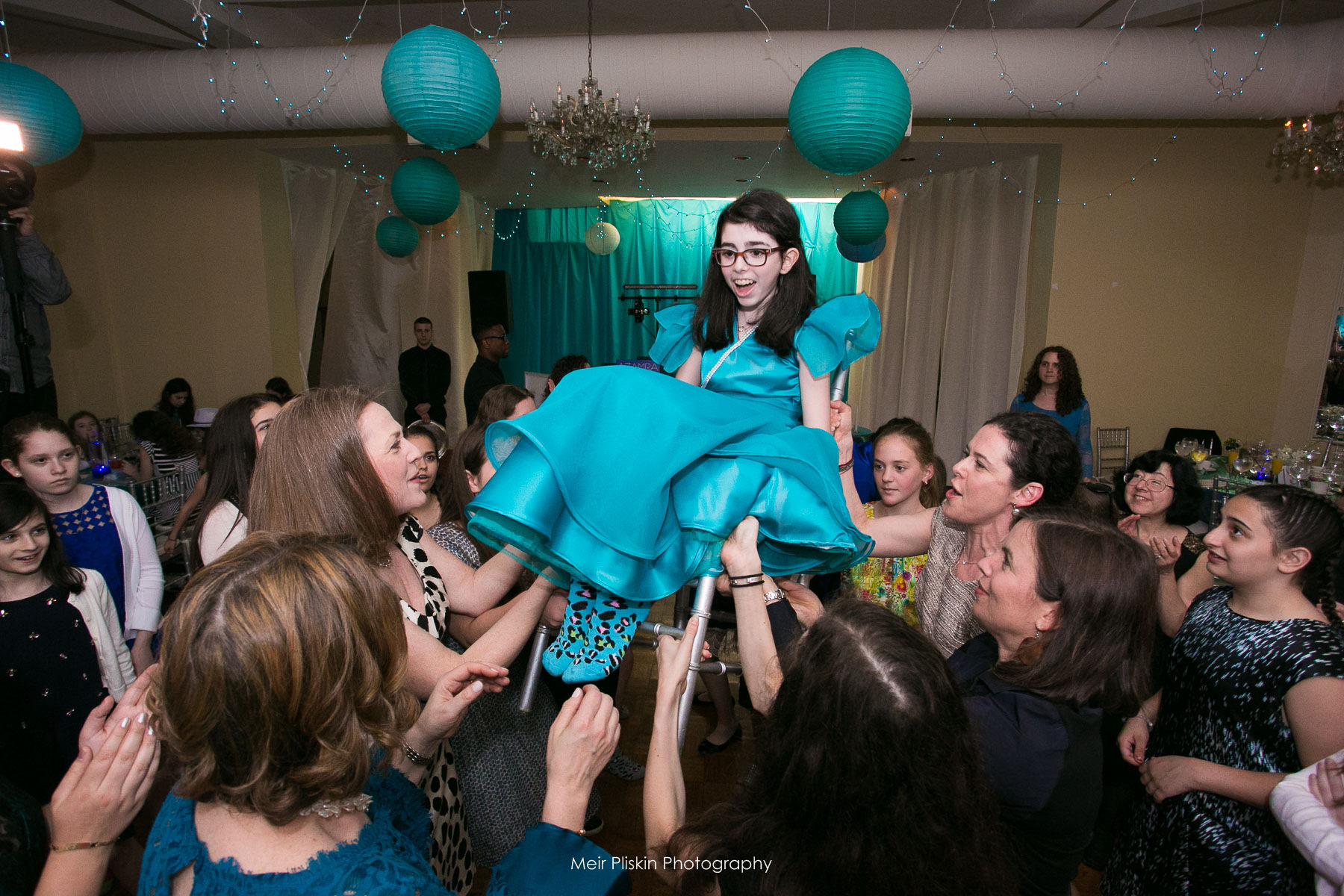


Sarah (Rosenberg) Schleifer from Teaneck, New Jersey recalls:
I am delighted to be able to attend the 75th anniversary celebration of Congregation Ramath Orah. I grew up in the shul and attended from 1950 – 1974. I lived with my parents, Jacob and Yetta Rosenberg, until I married – and then continued to attend as a married couple. My son’s Pidyon Haben was at Ramath Orah in May 1977; the whole shul was invited. My husband was trained by Cantor Kisner to assist with the yom tov davening and layning, and he did so for a number of years. I would love to reconnect with any who remember the shul in its glory days My father was shamos of the shul for many years and my mother was active in and President of the Sisterhood for several years.
When I attended we didn’t have formal youth programming. There were several of us that would run around downstairs during the rabbis’ speech. Rabbi Serebrenik insisted on decorum so there was no noise in the corridors outside the shul.
Ramath Orah exemplified for me what a shul was. No one spoke. The Rabbi would simply look at anyone who had the nerve to speak to a neighbor —and like a tractor beam—they would be silenced. The elegance of the stained glass windows and the beautiful organ (never used) set an almost royal tone for the shul.
Simchas Torah would be amazing for children. They would parade behind the men holding the sifrei torah. Each child received a gift bag and a flag and we would march around, receiving donations of more candy from both men and women in the shul and feeling like nobility as we marched around. The Sisterhood would sponsor a Bazaar every year as a fund raiser—they would collect donations of new things from members who had businesses and sell them over a few days. My job—as an older child and then teenager—was to straighten up the tables. It was such fun.
Elana Steltzer of White Plains, NY writes:
We obviously have so much to say about this one-of-a-kind shul and its incredible community. It took us five years of wandering on the Upper West Side to find a community that we could call home. From the moment we walked into Ramath Orah, we knew this shul was different than so many of the shuls we had explored as young couple living in Manhattan. Everyone was so friendly, kind, and hospitable. It quickly become our second home where we attended Shabbat services, observed holidays, participated in community events, and celebrated life milestones such as the birth of each of our three children. It is a place where our family made precious and close-knit friendships and our children learned to give back to their community. We have tremendous hakarat ha’tov to Ramath Orah for everything the shul and community has done for our family.
Below are some pictures of David and I speaking at Etai's bris, Rafi's seudah hoda'ah, our last Purim at CRO before moving to White Plains, and the dinner where we were honored with Daniel and Alisa Henkin.
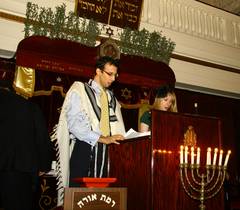
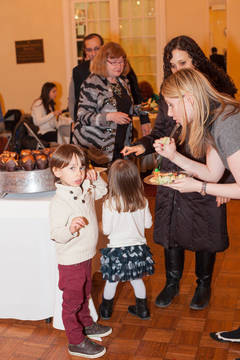
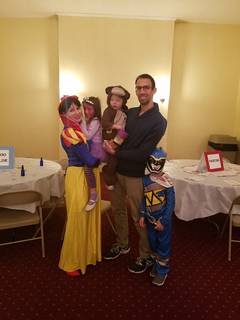
Dan Victor of New York, NY recalls:
I first came to Ramath Orah in the 1980s when Manny Tauber was President and Rabbi Feldman was the Rabbi. I’ve been at Ramath Orah through the Presidencies of Manny Tauber, Leo Chester, Jeff Bogursky, Jane Blumenstein, and Ann Goldhirsch, and the Rabbis were Rabbi Feldman, Rabbi Friedman, Rabbi Tokeah, and Rabbi Grussgott.
Leo Chester had the vision to transform the shul from a shteibel to a pluralistic Modern Orthodox shul. He cajoled, begged, bullied, and charmed everyone to go along with the transformation. Without him, it never would have happened.
My family has celebrated many life-cycle events at Ramath Orah, including the bar mitzvahs of my two sons, the bat mitzvah of my daughter, and the 50th wedding anniversary of my in-laws.
While there didn’t used to be any youth programming, there was always a “lollipop man”—Leo Chester, Don Wiengarten, and more recently, myself.
I remember years ago on Simchat Torah, the kids would tie up the ba’al mussaf and throw all sort of toys on him as he davened, and when he davened Geshem, they would sprinkle water from the organ loft—never on Leo or the Rabbi, though, usually on some hapless Columbia kid.
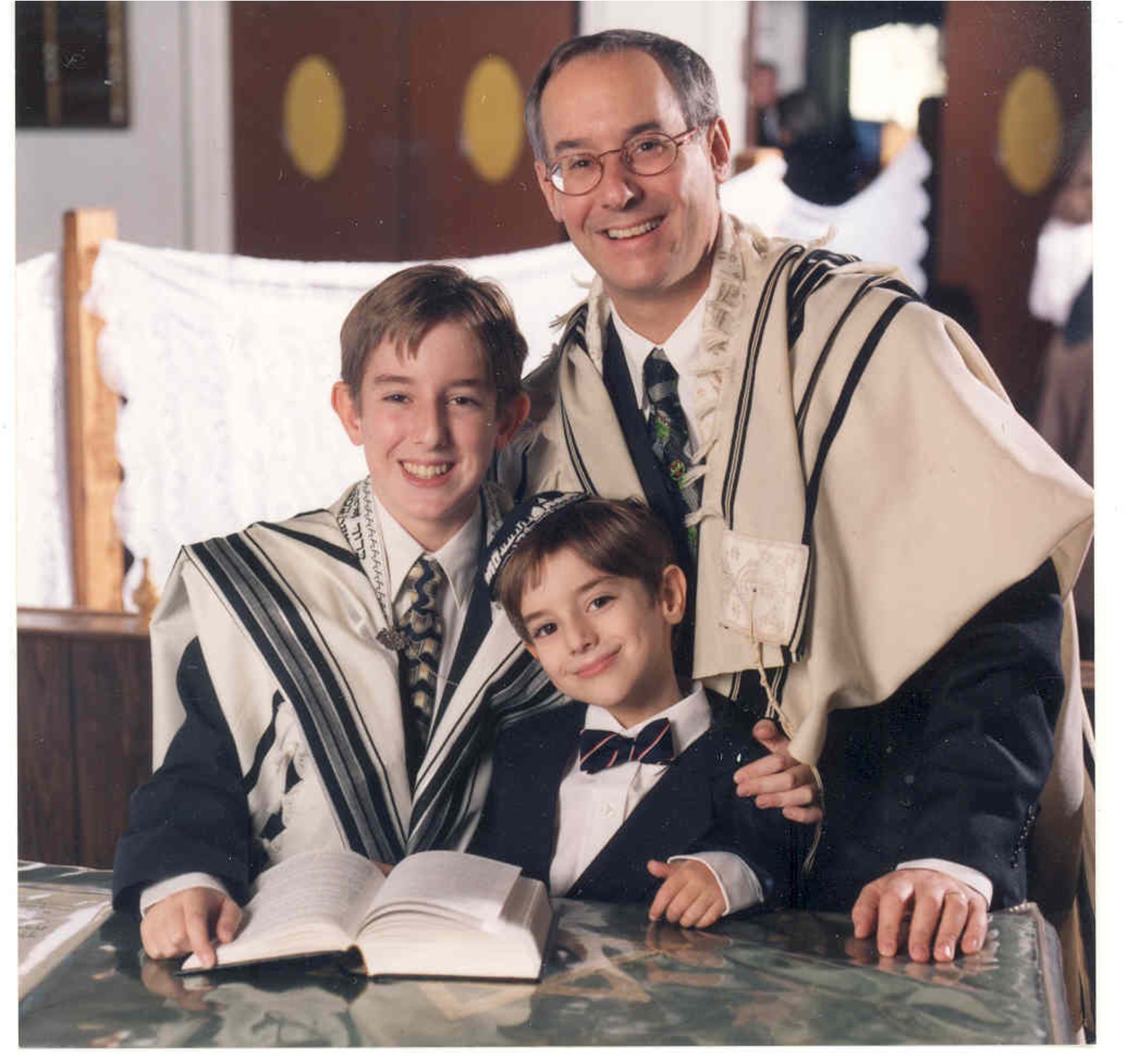
 Jacob Victor's Bar Mitzvah Max and Naomi Fuch's 50th anniversary
Jacob Victor's Bar Mitzvah Max and Naomi Fuch's 50th anniversary


Kal Victor's Bar Mitzvah
Sun, August 10 2025
16 Av 5785
Update this content.
Update this content.
Today's Zmanim
| Alot Hashachar | 4:28am |
| Earliest Tallit | 5:05am |
| Netz (Sunrise) | 6:01am |
| Latest Shema | 9:30am |
| Zman Tefillah | 10:41am |
| Chatzot (Midday) | 1:01pm |
| Mincha Gedola | 1:36pm |
| Mincha Ketana | 5:06pm |
| Plag HaMincha | 6:34pm |
| Shkiah (Sunset) | 8:03pm |
| Tzeit Hakochavim | 8:46pm |
| More >> | |
Update this content.
Today's Calendar
| Shacharit : 8:00am |
| Mincha : 7:45pm |
Tomorrow's Calendar
| Shacharit : 7:00am |
Join Our Mailing List
Office Hours
Monday–Friday 9:00 a.m.–2:00 p.m.
Email: inforamathorah@gmail.com
Privacy Settings | Privacy Policy | Member Terms
©2025 All rights reserved. Find out more about ShulCloud

